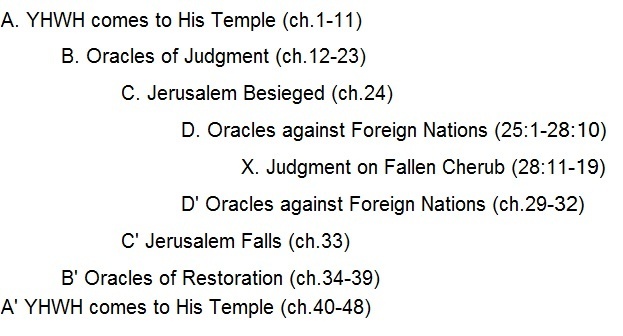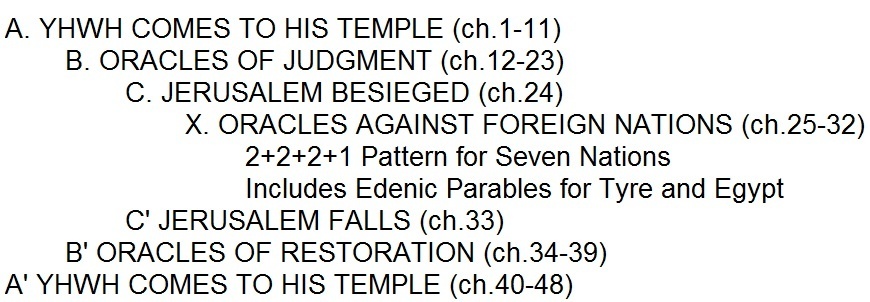In this post we will explore the structure of the climax of the book of Ezekiel (chapters 25-32) and then the turning point of Ezekiel 33 and look at the benefit of knowing this structure for the sake of interpretation and application.
We have seen the view that Richard M. Davidson argues in his article, “The Chiastic Literary Structure of Ezekiel,” in To Understand the Scriptures, where he asserts that the oracles against foreign nations are two parallel panels, each with seven sections and then the climax of the book (the judgment on the fallen cherub) is between these parallel panels.
The picture below then is how that fits into the structure of the book, in Davidson’s view.

The division of the text on the right hand side of the panel (see the panels on the handout from the previous post) is quite compelling and works only because the date formula is missing from the introduction to Ezekiel 30. Also compelling is that the oracle against Tyre follows much the same order as the oracle against Egypt. Surely we are to see the parallels that he is highlighting and to see that the oracles against foreign nations can be understood as two panels.
We would want to make one minor modification of his outline on the left hand side to fit the structure of the text – instead of “d” being Ezekiel 26:12-18 it would be better to argue that it is Ezekiel 26:15-18. There are simply no structural markers in verse 12 or immediately before or after it. But this is only a minor point.
The reason that he is arguing for the two panels is to make a way for the text of Ezekiel 28:11-19 to stand alone at the climax of the book. If Ezekiel had intended this, then he has ably provided for it on the right side in the clever undated introduction to Ezekiel 30. However, if Ezekiel had intended this, then the text on the left side is not as cleverly divided. On the left side there is only one dated introduction (Ezekiel 26:1) and some of the introductions are paragraph markers for the different parts of panel 1 concerning Tyre.
Again my objection is not to seeing that the oracle against Tyre follows the same order as the oracle against Egypt. No doubt Ezekiel wants his readers to see these parallels and perhaps even to think of these as parallel panels. The major objection that I would want to raise though is why could Ezekiel 28:11-19 not simply be part of the seventh section on the left side? Davidson has already ignored the introduction to Ezekiel 30 to make it work on the right side. What would argue against ignoring the introduction to Ezekiel 28:11-19 on the left side to make it work?
This objection is that much stronger when you realize that Ezekiel 30 begins, “The word of YHWH came to me: ‘Son of man…’” and Ezekiel 28:11 says, “Moreover, the word of YHWH came to me: ‘Son of man….’” Secondly, it is important to remember that we saw that Ezekiel 28:11-19 is part of the third panel concerning Tyre and has parallels with the second panel in particular and ends with the line that ends each panel. And thirdly, because Davidson supports his argument based on the content, it is important to remember that both oracles against Tyre and Egypt make Edenic comparisons.
That the text appears to generally, even with these problems in the details, fit into 2 panels is fitting given the 2+2+2+1 pattern of the oracles. It is also fitting, given that pattern, that there are 2 major oracles: those against Tyre and Egypt. And the fact that this one major theme regarding the Garden of Eden, does not fall at the same point in the order for Tyre’s oracle and for Egypt’s oracle, suggests that it is one that we should afford great significance.
In any case, I would suggest simplifying the chiasm of the book that Davidson had suggested as follows:

The important take-away for interpretation is to see that the whole of the oracles against foreign nations (chapters 25-32) is the climax of the book. And also, instead of the climax to the section being this nevertheless important parable or allegory about the prince of Tyre as a cherub in Eden, the climax to the section is the plus one (the seventh) oracle against Egypt. The significance of this entire section is that these foreign nations will no longer be a stumbling block to the people of God living long in the Promised Land.
With these oracles of bad news complete, now Ezekiel can move to the good news. It is important to remember that the good news is not good news without some related bad news first. The only event that Ezekiel is waiting for before making this shift is to hear from the survivor who will come tell him that Jerusalem has fallen to Nebuchadnezzar. This was predicted in Ezekiel 24 and will be fulfilled in the next chapter for us to explore Ezekiel 33.
Ezekiel 33:1-20 presupposes that Ezekiel will no longer be mute, which we see reported in Ezekiel 33:21-22. Ezekiel 33:21 begins the way we might have expected the chapter to open, giving us the date it was written. Duguid argues that chapter 33 is a chiasm centering on Ezekiel 33:21-22.
The chapter has two major halves, each half beginning “the word of YHWH came to me: son of man…” with the center as the climax:
The word of YHWH came to me: Son of man… (Ezekiel 33:1-20)
In the 12th year of our exile, in the 10th month, on the 5th day of the month, a fugitive from Jerusalem came to me and said, ‘The city has been struck down.’ Now the hand of YHWH had been upon me the evening before the fugitive came; and he had opened my mouth by the time the man came to me in the morning, so my mouth was opened, and I was no longer mute (Ezekiel 33:21-22).
The word of YHWH came to me: ‘Son of man…’” (Ezekiel 33:23-33)
Duguid argues for dividing the text as Ezekiel 33:1-11, 12-20, 21-22, 23-29, and 30-33. Thus the first and last sections stress hearing the prophetic word, the second and second to last sections focus on moral concerns. However, there is no reason not to divide the text earlier at verse 10, especially for reasons we will unpack below.
Thematically the chiasm then would be as follows:

Ezekiel 33:1-9 has two parts – Ezekiel 33:1-6 and 7-9. And these two parts are related in chiastic fashion. In the former the order is the case where the watchman warns the people and then the case where the watchman fails to warn the people. In the latter, the order is the case where the watchman (identified now as Ezekiel) fails to warn the people and then the case where the watchman (Ezekiel) warns the people. This chiastic order ties these two parts together as a unit as does this content in general.
Ezekiel 33:10-20 has two parts – Ezekiel 33:10-11 and 12-20. The basic point being that if the righteous backslides he will die, but if the wicked repents then he will live. And as we have seen elsewhere the emphasis is on repentance. In the first part the wicked ask how they can live and then God says that if they repent then they will live. In the second part Ezekiel lays out the case of the righteous person who backslides, then the case of the wicked person who repents. Then it says, “yet your people say, ‘the way of the Lord is not just,’ when it is their own way that is not just” (Ezekiel 33:17).
This is repeated more briefly in the same order: case of the righteous person who backslides and then the case of the wicked person who repents. Then it says, “yet you say, ‘the way of the Lord is not just.’ O house of Israel, I will judge each of you according to his ways” (Ezekiel 33:20). The reward is life and the punishment is death.
Thus the two parts of this half of the chapter, Ezekiel 33:1-9 and 10-20, each have two parts. This half of the chapter revisits themes we have seen earlier in Ezekiel (i.e. Ezekiel 3 and 18 in particular). The repetition of these themes here almost acts as a recommissioning for the prophet Ezekiel or perhaps simply a summary reminder of two very important points made earlier in the book. The rest of the book just like the portion that stressed the bad news, is part of Ezekiel’s calling as a watchman and to say that Ezekiel is asking the people to repent.
The second half of the chapter has two parts. Ezekiel 33:23-29 ends, “Then they will know that I am YHWH, when I have made the land a desolation and a waste because of all their abominations that they have committed” (Ezekiel 33:29). And Ezekiel 33:30-33 ends, “then they will know that a prophet has been among them.”
Ezekiel 33:23-29, like Ezekiel 33:10-20, features the wicked speaking. This wicked mention in particular Abraham who you will remember believed YHWH and He counted it to him as righteousness. They say, “Abraham was only one man, yet he got possession of the land; but we are many, the land is surely given us to possess.” So here the theme of life is replaced by the theme of the land.
While the parallel section (Ezekiel 33:10-20) gave the list of what repentance looks like, this one gives the list of what backsliding looks like. I say backsliding because Abraham was righteous but they are not. Both parallel sections include the oath formula, ‘Thus says the Lord YHWH: As I live…” (Ezekiel 33:11, 27). In the former section it was an oath that the repentant would live, here it is an oath that the wicked will die and the land be left desolate.
Ezekiel 33:30-33, like Ezekiel 33:1-9, shows the people come to Ezekiel to hear the warning but here we see that the wicked hear what Ezekiel says but will not do it. The last line presupposes the climax of the chapter, for it says, “When this comes—and come it will!–then they will know that a prophet has been among them.” What is the “this” that comes – it is the fall of Jerusalem, which we see reported at the center of the chapter.
It is the fall of Jerusalem that marks the change of tone for the entire book. Before the fall of Jerusalem Ezekiel preached judgment (with some brief glimpses of restoration), after the fall of Jerusalem Ezekiel preached restoration (with some brief messages of judgment). It is interesting then that this chapter puts it in the reverse order…that is, as you ascend the chiasm to the climax there is the stress on the positive option but as you descend the chiasm from the climax there is the stress on how the people chose the negative option.
But now that the disaster has come we will see messages of hope for those who repent. After death comes resurrection. The amazing thing is that the sword did not spare Jesus Christ but pierced Him too.
Recent Comments